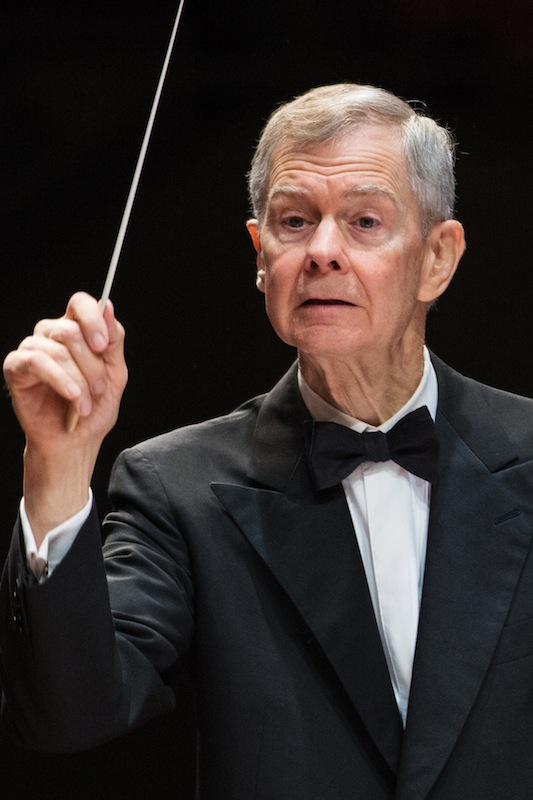A moving farewell in New England Philharmonic’s season finale

Richard Pittman conducted the New England Philharmonic Saturday night at the Tsai Performance Center.
In his seven years as composer-in-residence with the New England Philharmonic, David Rakowski has written four symphonies and a violin concerto, works that in their own ways showcase his characteristic musical drive and momentum.
But his Symphony No. 7 is a departure. As conductor Richard Pittman led the world premiere of the score with the NEP at the Tsai Performance Center Saturday night, in the orchestra’s season-ender, Rakowski’s music seemed a study in slow processes, soft colors, and stasis.
Actually a collection of tone poems inspired by nature that together clock in at 30 minutes, Rakowski’s Seventh Symphony leaves a lasting impression for its varying orchestral hues and overall intimacy. Written in graceful musical gestures, the symphony is a superb swan song for Rakowski as he steps down from his post at the end of the current season.
The arpeggio that opens the first movement, entitled “Water,” came to Rakowski as he awoke from a dream. Simple yet effective, it features strings and winds blurring together in shimmering sonorities, capturing in music, as the composer intended, the vision of sunlight on water. The motive makes up the raw material for much of the movement, though the music seems caught in the moment as lines swirl about in place.
That stasis continues in the second movement, “Air,” as woodwinds take over with fluttering figures. In “Earth,” they dissolve into stark string statements that are shaped with quick crescendos. Mid-movement, clarinets and flutes exchange bouncy, almost jazzy runs in a brief surge of energy.
But “Fire,” the final movement, has the most thrust. Thin harmonics in the strings flicker like candlelight before building in intensity without ever resulting in crushing sonorities or overblown gestures — rather, the symphony ends pensively.
Indeed, such contemplative resolutions are hallmarks of Rakowski’s orchestral style, and this subtle and searching music retains a power to linger in memory. In Saturday’s performance, Pittman led the orchestra in a reading marked by precision, elegance and fine control.
Saturday’s concert also featured the world premiere of Angela Elizabeth Slater’s Roil in Stillness, winner of the NEP’s annual call for scores. Like Rakowski, Slater drew upon the natural world for inspiration. Roil in Stillness, a tone poem composed in 2015, conjures the effects of rippling water as seen through a microscope.
It’s an attractive score and as its title suggests, chock-full of energy. Pittman and the orchestra delivered a vital and enthusiastic performance to make a strong case for this young composer.
Across 14 minutes, figures churn through each section of the orchestra, coming to rest on bristly dissonances before breaking away. Slater makes deft and vivid use of instrumental color. Brasses sound out heavy chords in climactic moments, and the large percussion forces supply a steady a rumble to propel the music forward. For all its power, Roil in Stillness concludes with a single high violin note evaporating into silence.
Yehudi Wyner’s Epilogue: in memory of Jacob Druckman brought contrasting stillness and uneasy peace. Only eight minutes in length, this emotionally charged score captures the composer’s sadness over the loss of a friend, Jacob Druckman, a significant American composer who died suddenly in 1996.
Wyner’s music for Epilogue is etched on a dark but thoroughly tonal canvas. Its opening churning figure is reminiscent of the opening of Sibelius’s Symphony No. 2, although Wyner says he borrowed the idea from Laurie Anderson’s electronic voice song, “O Superman.” Wyner’s variation encompasses cellos, violas, woodwinds and violins in turn. All build to a sweeping melody that appears and disappears like a fleeting thought. Pittman’s searching and iridescent treatment of orchestral color made this elegy palpably heartfelt two decades after Druckman’s death.
The evening’s solo spotlight fell upon concertmaster Danielle Maddon, who offered a real curio in Leoš Janáček’s Violin Concerto, a.k.a. The Wandering of a Little Soul. More curiosity than forgotten masterwork, this single-movement score, left unfinished, originated some of the themes the composer would later use in his opera The House of the Dead. Written in the composer’s bold, folk-inflected idiom, the concerto resembles his more popular Sinfonietta.
Maddon deftly maneuvered between its oddly shaped folk melodies, bristly dance rhythms, and fleeting waltzes, shading her lines with a mix of silvery and mahogany tone.
The orchestra provides more commentary than accompaniment, and Janáček changes directions on a dime, tossing out a brass fanfare in one instance and rough, driving string figures in another. Throughout, Pittman and the orchestra found all of the drama and rustic vitality in Janáček’s stark scoring.
An ensemble on the rise in recent seasons, the NEP continues to play with warm blend and delicate balance. The players’ technique has also become more focused and precise. Those elements were on display in the concert’s opener, Berlioz’s Overture to Béatrice et Bénédict.
Responding to Pittman’s quick, hammer-like gestures, the musicians rendered the opening waltz with lilt and swiftness. Supple brass chords introduced the lyrical theme, which unfolded into rich string phrases, the music never losing its operatic charm. The brief theme that makes up much of the overture moved with an unexpected Italianate grace that colored the entire performance. In the hands of Pittman and the orchestra, even old music manages to sound fresh and new.
The New England Philharmonic 2019-2020 season begins October 26 at the Tsai Performance Center. nephilharmonic.org
Posted in Performances